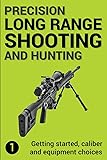Long-range shooting has surged in popularity over the past few decades, appealing to hunters, competitive shooters, and enthusiasts alike. Mastering this art requires not only skill but also a comprehensive understanding of various factors that influence accuracy at extended distances. This article serves as your essential handbook for long-range shooting, covering everything from the basics to advanced techniques, equipment choices, and mental preparation.
Understanding Long Range Shooting
Long-range shooting is generally defined as shooting at distances beyond 300 yards (274 meters). However, the exact definition can vary depending on the shooter’s experience level and the type of shooting involved. Several variables affect long-range accuracy, including:
- Ballistics: Understanding projectile motion, drop, and drift.
- Environmental Factors: Wind speed, humidity, and temperature.
- Equipment: The rifle, optics, and ammunition used.
- Shooter’s Skill: Marksmanship fundamentals, breathing control, and trigger squeeze.
The Physics of Long Range Shooting

To shoot accurately at long ranges, shooters need to grasp the principles of ballistics. Ballistics can be broken down into three categories: internal, external, and terminal ballistics.
Internal Ballistics
Internal ballistics deals with the processes occurring within the firearm from the moment the trigger is pulled until the bullet exits the barrel. Key factors include:
- Powder Charge: The amount and type of gunpowder can significantly influence velocity.
- Barrel Length: Longer barrels generally allow for more complete combustion of powder, resulting in higher velocities.
- Bore Condition: A clean and well-maintained barrel promotes better accuracy.
External Ballistics
External ballistics examines the bullet’s flight path from the muzzle to the target. Factors such as:
- Gravity: The bullet will drop over distance and must be compensated for.
- Wind: Crosswinds can push the bullet off course, requiring adjustments to aim.
- Air Density: Higher altitudes and warmer temperatures can reduce drag, affecting bullet travel.
Terminal Ballistics
Terminal ballistics refers to the behavior of the bullet upon impact with the target. Understanding this can help in choosing the right ammunition for hunting or target shooting.
Equipment Essentials for Long Range Shooting
Choosing the right equipment is crucial for long-range success. Here are key components to consider:
1. Rifles
Your rifle is the most critical piece of equipment. When selecting a rifle for long-range shooting, consider:
- Caliber: Popular calibers for long-range shooting include .308 Winchester, .6.5 Creedmoor, and .300 Winchester Magnum.
- Action Type: Bolt-action rifles are favored for their precision, while semi-automatics offer rapid follow-up shots.
- Weight: Heavier rifles tend to be more stable, while lighter models are easier to transport.
2. Optics

A quality scope is essential for long-range accuracy. Important features to look for include:
- Magnification: For long-range targets, scopes with variable magnification (e.g., 4-16x) are ideal.
- Reticle Type: Choose between traditional crosshairs or illuminated reticles for better visibility in low light.
- Adjustment Turrets: Look for scopes with precise and repeatable turrets for windage and elevation adjustments.
3. Ammunition

The choice of ammunition impacts both accuracy and terminal performance. Factors to consider include:
- Bullet Type: Match-grade bullets are designed for accuracy, while hunting bullets are designed for expansion upon impact.
- Consistency: Use ammunition from reputable manufacturers to ensure consistent performance.
Fundamentals of Long Range Shooting

Once you have your equipment, mastering the fundamentals is essential for effective long-range shooting. Key aspects include:
1. Positioning and Stability
Proper positioning enhances stability and accuracy. Techniques include:
- Prone Position: Offers maximum stability, ideal for long-range targets.
- Sitting and Kneeling Positions: Useful for field shooting where prone may not be feasible.
2. Breathing Control

Controlling your breathing can significantly improve shot accuracy. Follow these steps:
- Take a deep breath and let it out slowly.
- Pause briefly at the end of your exhale before squeezing the trigger.
3. Trigger Control
Good trigger control prevents jerking the shot. Proper technique involves:
- Using the pad of your finger to pull the trigger smoothly.
- Aiming at the target and applying pressure without disturbing your aim.
Adjusting for Distance: The Art of Dialing In
Long-range shooting requires adjustments based on distance, wind, and environmental factors. Here’s how to effectively dial in your shots:
1. Range Estimation
Estimating distance accurately is vital for making proper adjustments. Methods include:
- Rangefinders: Laser rangefinders provide precise distance measurements.
- Mil-Dot Reticles: These reticles help in estimating range based on known target sizes.
2. Windage and Elevation Adjustments

After estimating range, you must adjust for wind and bullet drop:
- Use ballistic calculators or apps to determine the necessary adjustments.
- Make incremental adjustments based on environmental conditions.
Mental Preparation for Long Range Shooting
The mental aspect of shooting is often overlooked but is critical for performance. Techniques to enhance focus and calmness include:
- Visualization: Envisioning successful shots can improve performance.
- Mindfulness Techniques: Practicing mindfulness can help maintain focus and reduce anxiety.
Case Studies and Statistics
Numerous case studies highlight the importance of proper training and equipment in long-range shooting. For example, a study conducted by the National Shooting Sports Foundation found that:
- Competitors who practiced regularly improved their accuracy by an average of 30% over six months.
- Participants using higher quality optics reported a 25% increase in hit rates at distances exceeding 600 yards.
Long-range shooting is a rewarding yet challenging sport that requires a solid understanding of ballistics, the right equipment, and mastery of shooting fundamentals. By focusing on these areas, shooters can progress from zero to infinity, achieving remarkable accuracy and confidence at extended distances. Remember, practice is key, so get out there, refine your skills, and enjoy the thrill of long-range shooting.